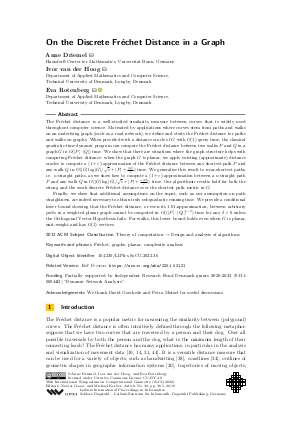@InProceedings{driemel_et_al:LIPIcs.SoCG.2022.36,
author = {Driemel, Anne and van der Hoog, Ivor and Rotenberg, Eva},
title = {{On the Discrete Fr\'{e}chet Distance in a Graph}},
booktitle = {38th International Symposium on Computational Geometry (SoCG 2022)},
pages = {36:1--36:18},
series = {Leibniz International Proceedings in Informatics (LIPIcs)},
ISBN = {978-3-95977-227-3},
ISSN = {1868-8969},
year = {2022},
volume = {224},
editor = {Goaoc, Xavier and Kerber, Michael},
publisher = {Schloss Dagstuhl -- Leibniz-Zentrum f{\"u}r Informatik},
address = {Dagstuhl, Germany},
URL = {https://drops.dagstuhl.de/entities/document/10.4230/LIPIcs.SoCG.2022.36},
URN = {urn:nbn:de:0030-drops-160448},
doi = {10.4230/LIPIcs.SoCG.2022.36},
annote = {Keywords: Fr\'{e}chet, graphs, planar, complexity analysis}
}

 Creative Commons Attribution 4.0 International license
Creative Commons Attribution 4.0 International license
































